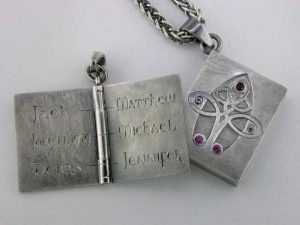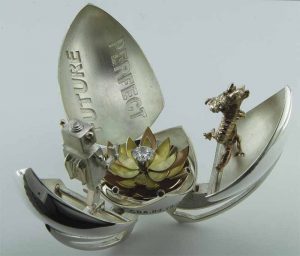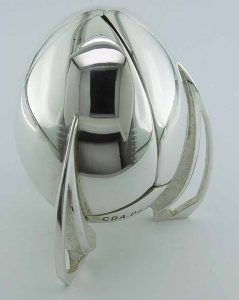Versatile and timeless

Silver’s inherent malleability and ductility make it very suitable for making both jewellery and elaborate holloware and cutlery. Sadly, many beautiful collections of ancestral sterling silver flatware, tea sets, and other objects have been sold for silver scrap in recent years. Modern lifestyles don’t appear to fit with housewares that require the amount of care (i.e. handwashing and occasional polishing) silver requires. Sure, stainless steel can go in the dishwasher—but old stainless simply looks like old steel, while old sterling silver develops a rich and beautiful patina only this metal can achieve.
Silver jewellery has a long historical tradition, having been made using techniques still employed today. Originally, silver was beaten into thin sheets and decorated with repousse or applied ornamentation such as granulation. It was cast using the lost wax process. The intricacy and beauty ancient craftspeople achieved with relatively primitive tools is humbling in this era of laser welders and computer-aided design (CAD).
Today, we automatically think of setting diamonds in platinum or white gold. When diamonds first became popular in jewellery, however, they were typically set in silver to better showcase their white brilliance. To provide greater strength, these silver settings were backed with yellow gold. Of course, silver does tarnish when exposed to sulphur in the environment, and these older settings needed to be polished at intervals. However, there is a gentle luminosity to antique gold-backed diamonds set in silver. The metal takes a back seat and lets the diamonds shine. When it became possible to work platinum, even it was initially backed with yellow gold, honouring tradition.
Modern silver
When I first began my jewellery career, I—like many of my colleagues—worked exclusively in silver. I could not afford gold and learned how to deal with both the advantages and problems inherent in the metal. This turned out to be excellent training. If you can work successfully with silver, gold and platinum will, for the most part, be far less of a challenge.
Silver, due to its relatively low cost, can be used to create jewellery that has more mass/weight without breaking the bank. This has made it very popular in recent years as the world economy has faltered. Many talented designers have added collections of silver jewellery to their lines. Some pieces are entirely sterling, while others use silver as the base of the piece and accent this with smaller quantities of gold, platinum, or palladium as contrast.







